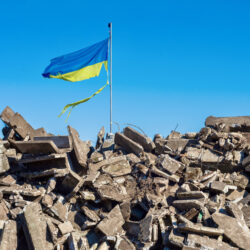Artillery supply chains are Russia’s Achilles heel

The most effective way to disrupt Russia’s war effort in Ukraine is to attack its artillery supply chains. That is the conclusion of a new report by the Royal United Services Institute (RUSI) and the Open Source Centre (OSC). ‘Ore to Ordnance: Disrupting Russia’s Artillery Supply Chains’ highlights the central role artillery plays in Russia’s invasion of Ukraine. Denying Russia access to essential artillery and ammunition components would significantly weaken the country’s military strength, according to the report.
By Henrieke Wagenvoort
Attempts to disrupt the Russian defence industry on a large scale have had limited success to date, the report states. This is because they have often targeted the most essential components, such as microchips. Getting access to these is extremely difficult. Instead, RUSI and OSC suggest targeting specific vulnerabilities in artillery supply chains. Indeed, Russia’s Achilles heel is its dependence on foreign imports for key raw materials, including chromium, which is essential for the production and maintenance of howitzer barrels, for example.
‘Ore to Ordnance’, based on fieldwork in Ukraine and open-source data, provides a detailed blueprint for policymakers seeking to weaken Russia’s military capabilities by disrupting the supply of artillery (howitzers and shells, for example). Such a targeted approach could lead to more effective sanctions and actions that would deter Russia from maintaining its military dominance on the battlefield, according to the report.
Import of chrome
Underlying the report is a comprehensive study of the various links in the artillery supply chains, from raw materials such as iron ore to the supply of finished artillery systems. It identifies several critical bottlenecks on which foreign governments could exert pressure. For example, Russia imports most of its chrome from countries such as Kazakhstan and South Africa. This is an important supply chain vulnerability that could be exploited through sanctions and other diplomatic means.
Besides being dependent on foreign raw materials, Russia’s defence industry is currently struggling to expand its production capacity due to a shortage of skilled labour and an outdated transport infrastructure. The report suggests that this expansion can also be slowed down by tackling imports of specialized machinery such as computer numerical control (CNC) machines, which process raw materials into a particular end product. These machines mainly come from China.
Production of artillery
While the report acknowledges that the Russian defence industry has shown resilience, especially by adapting to sanctions, it stresses that Western focus should be on blocking imports that are crucial for artillery production. Western governments have the means to exploit these vulnerabilities through coordinated sanctions, trade restrictions and international cooperation, the report says.
The war in Ukraine has proved costly for Russia. The report underlines that the country’s ability to continue producing and supplying artillery to its troops remains a key advantage. However, by strategically targeting artillery supply chains, Ukraine’s Western allies can weaken Russia’s offensive and defensive capabilities. The balance of the conflict could thus tip in Ukraine’s favour, according to ‘Ore to Ordnance’.










